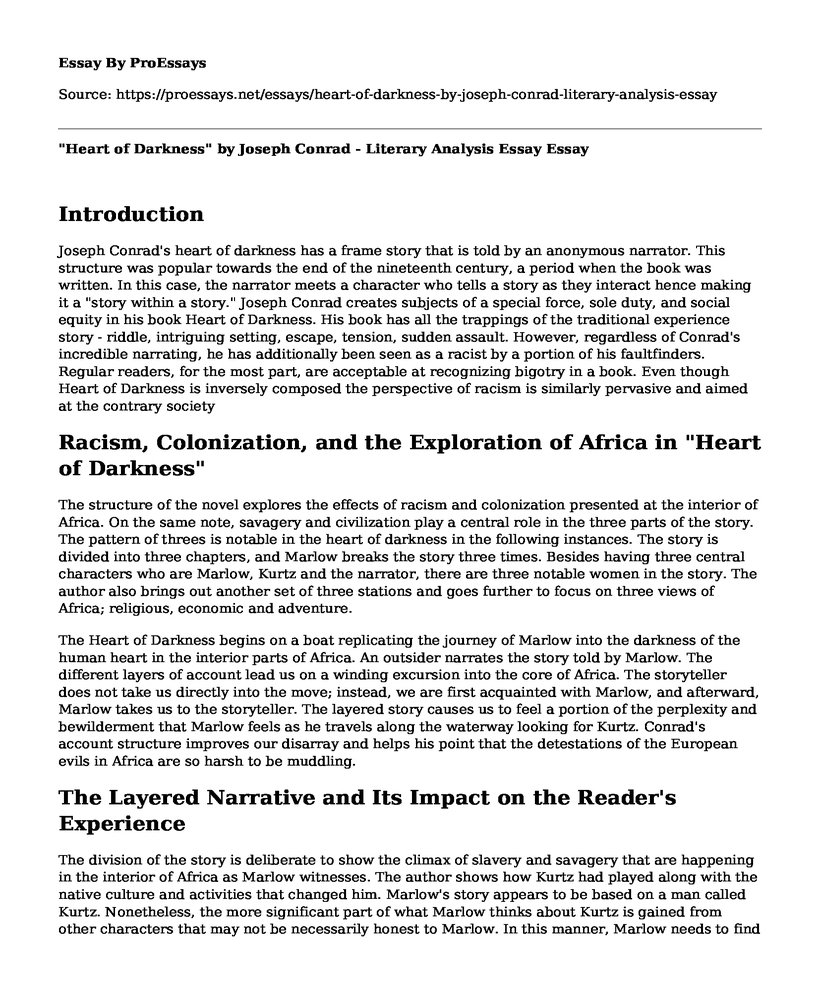Introduction
Joseph Conrad's heart of darkness has a frame story that is told by an anonymous narrator. This structure was popular towards the end of the nineteenth century, a period when the book was written. In this case, the narrator meets a character who tells a story as they interact hence making it a "story within a story." Joseph Conrad creates subjects of a special force, sole duty, and social equity in his book Heart of Darkness. His book has all the trappings of the traditional experience story - riddle, intriguing setting, escape, tension, sudden assault. However, regardless of Conrad's incredible narrating, he has additionally been seen as a racist by a portion of his faultfinders. Regular readers, for the most part, are acceptable at recognizing bigotry in a book. Even though Heart of Darkness is inversely composed the perspective of racism is similarly pervasive and aimed at the contrary society
Racism, Colonization, and the Exploration of Africa in "Heart of Darkness"
The structure of the novel explores the effects of racism and colonization presented at the interior of Africa. On the same note, savagery and civilization play a central role in the three parts of the story. The pattern of threes is notable in the heart of darkness in the following instances. The story is divided into three chapters, and Marlow breaks the story three times. Besides having three central characters who are Marlow, Kurtz and the narrator, there are three notable women in the story. The author also brings out another set of three stations and goes further to focus on three views of Africa; religious, economic and adventure.
The Heart of Darkness begins on a boat replicating the journey of Marlow into the darkness of the human heart in the interior parts of Africa. An outsider narrates the story told by Marlow. The different layers of account lead us on a winding excursion into the core of Africa. The storyteller does not take us directly into the move; instead, we are first acquainted with Marlow, and afterward, Marlow takes us to the storyteller. The layered story causes us to feel a portion of the perplexity and bewilderment that Marlow feels as he travels along the waterway looking for Kurtz. Conrad's account structure improves our disarray and helps his point that the detestations of the European evils in Africa are so harsh to be muddling.
The Layered Narrative and Its Impact on the Reader's Experience
The division of the story is deliberate to show the climax of slavery and savagery that are happening in the interior of Africa as Marlow witnesses. The author shows how Kurtz had played along with the native culture and activities that changed him. Marlow's story appears to be based on a man called Kurtz. Nonetheless, the more significant part of what Marlow thinks about Kurtz is gained from other characters that may not be necessarily honest to Marlow. In this manner, Marlow needs to find out quite a bit about Kurtz's story. As such, the reader gets to know Kurtz gradually by interpreting Marlow's reactions. The structure also resembles the Russian nesting dolls where you will find another doll inside of each doll once you open them. A lot of meaning and significance of the heart of Africa is not derived from within the story but rather its periphery. This aspect is evident when considering the following three scenarios, first is when Marlow's experience in Brussels, second is Nellie's experience when Marlow is telling the story and lastly, is the effect on the reader as they read the story.
Part of the meaning in the story is brought out by the way in which the reader gets to learn about 'reality' through other people's tales, of which most of them have been narrated more than twice by other characters. Another meaning heart of darkness is also brought out by the unreliability of our informers. For instance, at one point, Marlow is the storyteller, and at another point, he is a flawed character in the story.
Conclusion
In conclusion, racism is depicted in Conrad's novel; however, one must recognize that harking back to the eighteen hundred, the community fit in with it. Conrad likely would have been scrutinized as being caring as opposed to racism back in his time. Conrad continually alluded to the locals, in his book, as dark savages, niggers, beasts, and "them," showing numbness toward the African history and bigotry towards the African individuals. Conrad expressed, "Dark figures walked around drowsily.
Cite this page
"Heart of Darkness" by Joseph Conrad - Literary Analysis Essay. (2023, Apr 05). Retrieved from https://proessays.net/essays/heart-of-darkness-by-joseph-conrad-literary-analysis-essay
If you are the original author of this essay and no longer wish to have it published on the ProEssays website, please click below to request its removal:
- A Literary Essay Sample: Ordinary Men Response
- The Significance of the Title 'Fences' Essay
- Compare and Contrast Paper on Mora's Poems: La Migra and Elena
- Literary Analysis Essay On "The Odd Women" by George Gissing
- Principles of Literary Study for Poetry Paper Example
- Essay Example on The Tell-Tale Heart: Edgar Allan Poe's Study of Guilt and Reason
- Modernism in EE Cummings' Poetry: Exploring Individualism, Experimentation and Absurdity - Essay Sample







